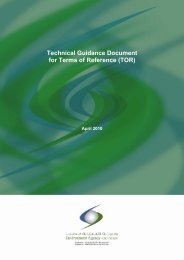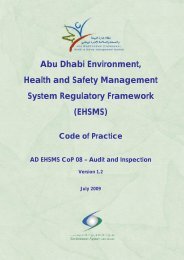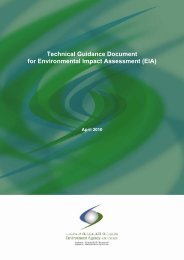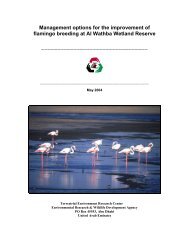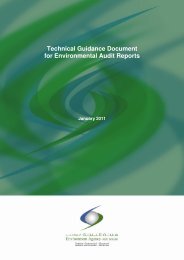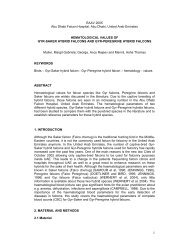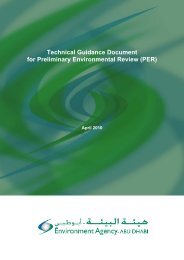Technical Guidance Document for Environmental Action Plan (EAP)
Technical Guidance Document for Environmental Action Plan (EAP)
Technical Guidance Document for Environmental Action Plan (EAP)
Create successful ePaper yourself
Turn your PDF publications into a flip-book with our unique Google optimized e-Paper software.
<strong>Technical</strong> <strong>Guidance</strong> <strong>Document</strong> <strong>for</strong> <strong>Environmental</strong> <strong>Action</strong> <strong>Plan</strong><br />
When complex or major problems are identified and there is the risk of immediate impact to the<br />
environment, the selection of corrective actions should reflect the severity of the problem. In such<br />
instances, the decision process should be provided <strong>for</strong> the methods or technologies chosen, including<br />
a cost/benefit analysis. This will enable EAD to evaluate if all potential options <strong>for</strong> corrective actions<br />
were considered in making the decision and that the most applicable option was chosen.<br />
For those problem findings that may require remediation of past contamination, the corrective action<br />
should detail sampling, monitoring, and/or remediation activities to be per<strong>for</strong>med at the site. Although<br />
remediation of site contamination would be necessary to clean up the existing contamination, the<br />
remediation activity alone would not fully resolve the finding because it does not address the root<br />
cause of the release. There<strong>for</strong>e, the <strong>EAP</strong> should include details of the clean-up activities, as well as<br />
remedies <strong>for</strong> improper activities that caused the contamination. All sampling, analysis, and monitoring<br />
proposed in an <strong>EAP</strong> should be according to EAD–approved standards and methodologies. In addition,<br />
the <strong>EAP</strong> should include detailed sampling, analysis, monitoring, or remediation plans that cite EAD or<br />
internationally recognised standards or methodology being implemented.<br />
Please not that an Abu Dhabi Waste Management Centre-approved environmental service provided<br />
must be used <strong>for</strong> waste collection, treatment, transportation and disposal.<br />
4.2 Schedule<br />
The <strong>EAP</strong> should include a schedule with projected dates <strong>for</strong> initiating, completing, and implementing<br />
each of the corrective actions. The planned completion date should be reasonable based on priority of<br />
the corrective action, availability of resources needed, amount of time needed to close each activity<br />
(e.g., publish the procedure, implement the procedure, train workers on the procedure), and evidence<br />
needed to verify closure.<br />
The schedule should include the planned <strong>EAP</strong> completion date when all corrective actions are to be<br />
completed. If corrective actions will require significant time to complete and implement, interim<br />
corrective actions and/or compensatory measures should be developed that will be implemented<br />
pending completion of the corrective action to reduce the possibility of an event or condition<br />
occurrence. A description of these interim or compensatory actions, including when they will be<br />
implemented, should be addressed in the <strong>EAP</strong>.<br />
5. Closure and Effectiveness Review<br />
Each of the corrective actions addressed in the <strong>EAP</strong> should be tracked <strong>for</strong> two purposes:<br />
• Verification of completion and implementation of the corrective actions or closure<br />
• Determination of the effectiveness of the corrective actions in successfully resolving and<br />
preventing recurrence of each finding.<br />
It is important to determine whether the corrective actions collectively resolve the contributing<br />
factors, including the root causes involved in that specific problem finding, and if they will prevent<br />
recurrence.<br />
The <strong>EAP</strong> should detail the process <strong>for</strong> verifying closure of the corrective actions, including a<br />
description of the ways in which the <strong>EAP</strong> and associated corrective actions will be tracked and<br />
reported internally and to EAD until completion.<br />
If applicable, where corrective actions have not effectively resolved the finding or prevented<br />
recurrence, the reason(s) that the corrective actions were ineffective should be determined and<br />
reported to EAD in follow-up or subsequent status reports. This would include a review of the<br />
problem finding evaluation, development of the corrective actions, and implementation of those<br />
corrective actions. Revised or additional corrective actions should then be identified to effectively<br />
resolve the finding and prevent recurrence.<br />
10





